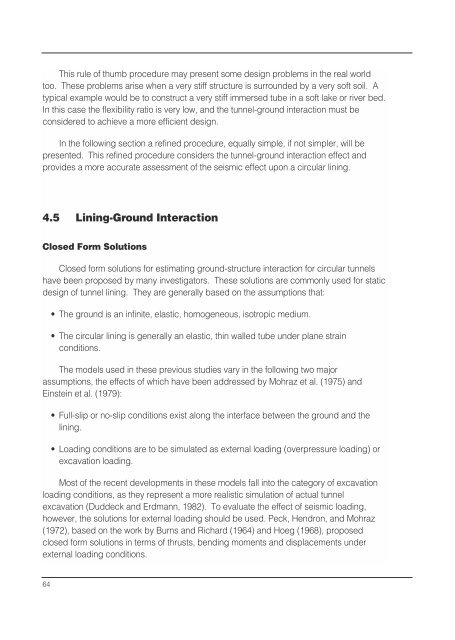Seismic Design of Tunnels - Parsons Brinckerhoff
Seismic Design of Tunnels - Parsons Brinckerhoff
Seismic Design of Tunnels - Parsons Brinckerhoff
You also want an ePaper? Increase the reach of your titles
YUMPU automatically turns print PDFs into web optimized ePapers that Google loves.
This rule <strong>of</strong> thumb procedure may present some design problems in the real world<br />
too. These problems arise when a very stiff structure is surrounded by a very s<strong>of</strong>t soil. A<br />
typical example would be to construct a very stiff immersed tube in a s<strong>of</strong>t lake or river bed.<br />
In this case the flexibility ratio is very low, and the tunnel-ground interaction must be<br />
considered to achieve a more efficient design.<br />
In the following section a refined procedure, equally simple, if not simpler, will be<br />
presented. This refined procedure considers the tunnel-ground interaction effect and<br />
provides a more accurate assessment <strong>of</strong> the seismic effect upon a circular lining.<br />
4.5 Lining-Ground Interaction<br />
Closed Form Solutions<br />
Closed form solutions for estimating ground-structure interaction for circular tunnels<br />
have been proposed by many investigators. These solutions are commonly used for static<br />
design <strong>of</strong> tunnel lining. They are generally based on the assumptions that:<br />
• The ground is an infinite, elastic, homogeneous, isotropic medium.<br />
• The circular lining is generally an elastic, thin walled tube under plane strain<br />
conditions.<br />
The models used in these previous studies vary in the following two major<br />
assumptions, the effects <strong>of</strong> which have been addressed by Mohraz et al. (1975) and<br />
Einstein et al. (1979):<br />
• Full-slip or no-slip conditions exist along the interface between the ground and the<br />
lining.<br />
• Loading conditions are to be simulated as external loading (overpressure loading) or<br />
excavation loading.<br />
Most <strong>of</strong> the recent developments in these models fall into the category <strong>of</strong> excavation<br />
loading conditions, as they represent a more realistic simulation <strong>of</strong> actual tunnel<br />
excavation (Duddeck and Erdmann, 1982). To evaluate the effect <strong>of</strong> seismic loading,<br />
however, the solutions for external loading should be used. Peck, Hendron, and Mohraz<br />
(1972), based on the work by Burns and Richard (1964) and Hoeg (1968), proposed<br />
closed form solutions in terms <strong>of</strong> thrusts, bending moments and displacements under<br />
external loading conditions.<br />
64
















